Bowens Gemini 750+ Travel Pak
For a while I was tempted to acquire a minimal Studio Lighting kit in order to hone my skills and better understand the technique. Of course, I needed some other justification to make it fit in "the grand scheme of things" as even a small set-up can be expensive if it is of good quality. The justification was found easily: studio lighting is widely used in wildlife photography on set-up shots, where the environment is re-created in the studio and on nocturnal shots taken from a hide. To satisfy both requisites, I needed a light, portable kit that could easily be powered from a battery. It also needed to be affordable but of good enough quality to accompany me in my career for a long time.
A long search on the Internet yielded two contenders: The Profoto B2 and the Bowens Gemini with Travel-Pak. Now, Profoto is the Hasselblad of studio lighting. Their kit is so sexy it hurts your eyes even when it is turned off. It is modern, has every gadget built in and, I suppose, is of the best possible quality. I was tempted.
But Bowens does have a couple of things going for them. Their new Gemini heads are stand alone, meaning that they are independent of their power source which can be either the Travel-Pak battery or a mains lead. They can be adjusted independently and used alongside any other setup. They are easily available on the net and cost about one fourth of the Profoto kit. The two head kit with stands, umbrella, light box and battery costs about £1099 for 500 Watts but I went for the faster 750+ at £1499.
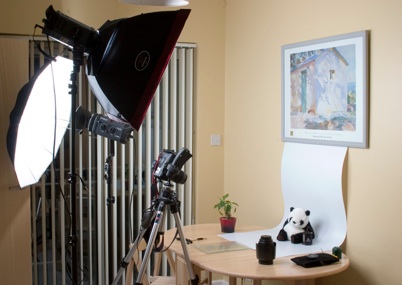
Open the box, clear out the kitchen and presto, a studio!
Using the Gemini couldn't be simpler. Nothing much is automated but you've got nice big knobs for everything. The Power knob will adjust flash output over 5 stops down to 1/32 and the modelling light will mimic the output when twisted to the same position. What attracted me to the 750+ was the short flash duration, 1/2380s, important for working with insects and birds, but also the very short recycling time, 1.41 seconds. The guide number is 104.4, more than enough power for my use. There is a very practical built in cell trigger so only one head needs to be wired to the camera (I decided to use a wireless trigger also made by Bowens, the Pulsar).
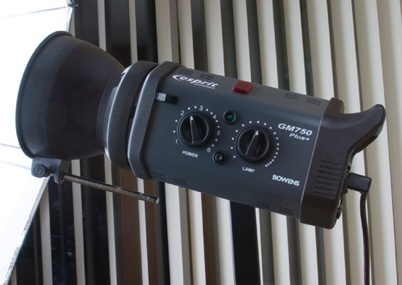
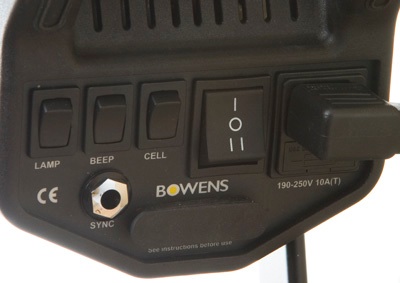
The back of the head is as simple as the side but not well labelled. The lamp switch for example has two positions: on, and off while recycling which gives a good confirmation that all heads fired by switching off the modelling light until the flashes are ready again. The master switch could be confusing as well: position I is for mains power and position II for using the battery, its DB25 connector hidden under a rubber cap. The documentation is extremely succinct and doesn't help but then the system is simple enough for it not to be much of a problem.
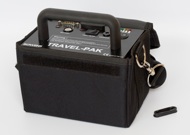
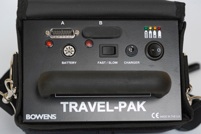
The Travel-Pak completes the kit. It holds a small lead-acid battery safely encased in a plastic bucket so as to be reasonably weather proof. The handle is sturdy and the Pak comes in a canvas bag with a shoulder strap. Controls are limited: a fast/slow recycling switch which allows you to save a bit of power if needed by slowing the charging of the heads. A battery socket can be used to daisy chain an external battery for additional power. The Travel-Pak will give about 200 flashes using 500 watt heads. A tiny disappointment are the rather low tech DB25 connectors used to power the heads but they help keep the costs low.
Using the kit is straightforward, a benefit of its lack of sophistication. The costs are fortunately few: if you reduce the power, you'll need to discharge the flash at the previous power setting before being able to use the new setting. Also, the flashes seem to go into sleep after a while and the first picture to wake them up will be out of sync.
I had a rather good time experimenting with the set-up, both on the mains and with the Travel-Pak when one of the flashes failed. It would fail to discharge whatever trigger I used. I tried a few things then resigned myself to contact technical service at Bowens. I started with an email then called. The phone was answered on the first ring by somebody who actually knew about the product and trusted me to have diagnosed a real failure. He suggested I send the flash back after only a couple of minutes. Then I received a call from another engineer who had just read my email and wanted to make sure my problem was being solved. I received my repaired unit a few days later.
The "S-Type" bayonet makes modifiers secure and easy to swap. The umbrella and light box provided are small but a good start, allowing for a number of combinations but soon making you hungry for more. In fact, this is the only problem. While there are tons of things you can do with two lights, you can always do them better with more lights and more sophisticated modifiers.
Not unlike lenses then...

9 March 2006